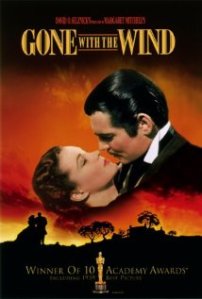Rating: 2½ stars (out of 4)
Gone with the Wind (1939): Directed by Victor Fleming, with contributions by George Cukor and Sam Wood. Written by: Sidney Howard, with contributions by Oliver H.P. Garrett, Ben Hecht, Jo Swerling, and John Van Druten. Based upon the novel of the same nameby Margaret Mitchell. Starring: Vivien Leigh, Clark Gable, Olivia de Havilland, Leslie Howard, and Hattie McDaniel. Unrated. Running time: 238 minutes.
 An acknowledged film classic by critics and audiences alike, Gone with the Wind thrives on its grand scale, making it perhaps the quintessential Hollywood film. How well has the old classic aged, though?
An acknowledged film classic by critics and audiences alike, Gone with the Wind thrives on its grand scale, making it perhaps the quintessential Hollywood film. How well has the old classic aged, though?
Beginning on the eve of the Civil War, Wind introduces us to Scarlett O’Hara, a Southern belle with the attitude of a petulant child. She aims to marry Ashley Wilkes, the son of a plantation owner, who has just been engaged to his cousin Melanie. When the charming, self-confessed scoundrel Rhett Butler comes into Scarlett’s life, we’ve got a love-quadrangle on our hands. The film extends through the war to its aftermath, across many years and marriages.
Because of the film’s scale, and its literary basis, everything here is larger than life. From the score to the screenplay, from the acting to the cinematography, the film readily awes with production values. Sometimes, that production value effectively conveys the intricacies of Southern life. We do see the horrors of Civil War life, including the sacking of Atlanta. Other times, the film’s “bigness” oversimplifies the complicated emotions of the characters, and over-romanticizes historical events.
I find the Scarlett O’Hara character alternately fascinating and insufferable. But while she mostly comes off mostly as the latter, the film admires Scarlett’s strengths while condemning her flaws, smartly utilizing the impeccable Clark Gable and the magnificent Hattie McDaniel as Scarlett’s consciences.
A word about racial stereotypes: they’re definitely here. As a product of 1939, this epic offers two options for its black characters: do-gooding slaves like Mammy and Prissy, or naïve putzes under Yankee influence. No middle ground exists, and that’s a shame—the film squanders the chance for humanity in certain characters.
I admire the film more for its moments than as a whole, but for those interested in American film history, it’s still a must-see.
Next film: Rebecca, 1940